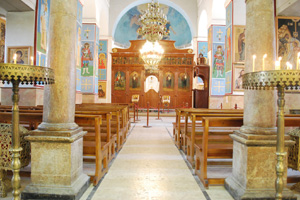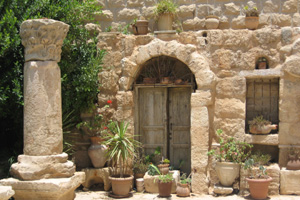|
The town Madaba is well known for its Byzantine and Umayyad mosaics. Popular is especially the 6th century mosaic map of Palestine in the floor of the greek orthodox St. George's Church. Other magnificent mosaic masterpieces from the Madaba area, mostly found in old churches, can be seen in the Archaeological Park.
Just 30 kms from Amman Madaba, the biblical Medeba, is located. In the 5th century a large Christian community with an own bishop had been living here. In the 19th century the Latin Patriarchate of Jerusalem started with archaeological researches. In 1896 the famous map of the Holy Land was discovered. This map was originally part of the floor of a Byzantine church, built during the reign of emperor Justinian 527-565 AD. It is the oldest, still existing map of the Holy Land.
With two million pieces of local, coloured stone, the map depicts hills and valleys, villages and towns in Palestine and the Nile Delta. Most of the mentioned sites are in modern Israel, for example, the map marks Jericho with palm trees, Jacob's well in Shechem, John's baptism of Jesus in the Jordan River. The focus of the map is Jerusalem, you can see here city walls, the Cardo and the Church of the Holy Sepulcher. The mosaic map was originally around 15.6 x 6 meters large, only about a quarter is preserved.
Beside the Holy Land map other marvelous mosaics had been excavated in Madaba, that's why the town is known as the "city of mosaics". Masterpieces found in the church of the Virgin Mary and the Apostles, the Church of Prophet Elijah and the Hippolytus Mansion. You can watch the masterpieces in the Archaeological Park. Founded in 1992 the Mosaic School of Madaba, the only project of its kind in the Middle East, trains artisans in the art of making, repairing and restoring mosaics. |


|